Astronomy Program News & Events
see also: McDonald Observatory press room / archive
2014
Giant Magellan Telescope
December 2014
The extremely stable components of the 1,200 ton Giant Magellan Telescope are designed to virtually eliminate vibration during operation. The full structure will float on a thin bearing of oil, never touching the ground. Each 17 ton mirror will float on a cushion of air, never touching the telescope. The secondary mirror, 15 stories above, will float by magnetism, oscillating and reshaping in real time as adaptive optics cancels atmospheric distortion.
Watch an informal overview of the Giant Magellan Telescope by Director Pat McCarthy from Sep 2013 at SlidesLive.
[James Tyrwhitt-Drake]
A timelapse of the Sun in 4K
December 2014
The surface of the sun from October 14th to 30th, 2014, showing sunspot AR 2192, the largest sunspot of the last two solar cycles (22 years). The animation shows the sun in the ultraviolet, at a rate of 52.5 minutes per second, using more than 17,000 images produced by the Solar Dynamics Observatory [Helioviewer]. The view is rotated 180 degrees so that south is "up". The audio is processed from SOHO HMI data by Alexander G. Kosovichev. Image data courtesy of NASA/SDO and the AIA, EVE, and HMI science teams. Mouseover for full screen option..
Public Lecture
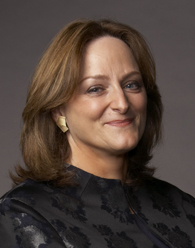
Black Holes, Galaxies and the Evolution of the Universe: An Observer's View
Prof. Meg Urry - Yale University
Wed., Dec. 3, 4:00 PM · ECJ 1.202
Visit of Dr. Urry
Dec. 2-5
also.. Women in Natural Sciences presents: "Why So Few? The Dearth of Women in Science" with Dr. Meg Urry
Thurs., Dec. 4, 4:00 PM · NHB 1.720 · Details
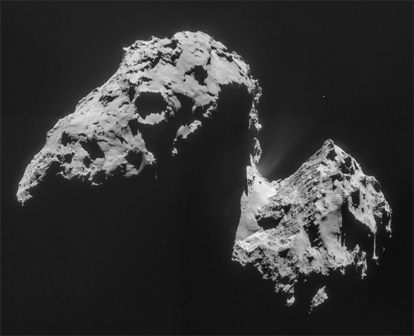
[ESA/Rosetta/NAVCAM]
Dramatic Landing for Philae Marks First Touchdown on a Comet
November 2014
WIRED consults with planetary scientists, including McDonald Observatory Asst. Director Anita Cochran, on the milestone encounter with comet 67P/Churyumov-Gerasimenko. In coming months, from the surface, the lander will collect and submit data as the comet approaches the sun, emits jets of gas and changes shape, perhaps even breaking apart.
WIRED
What’s Next for the Rosetta Mission and Comet Exploration
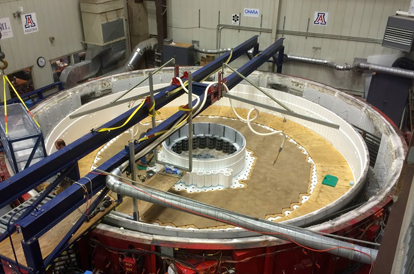
[University of Arizona]
Oven Mold for GMT Segment 4
November 2014
This October photo from the University of Arizona Mirror Lab shows the construction of the furnace mold for the Giant Magellan Telescope's 4th mirror segment. This segment will have an opening in the center, for light to pass from secondary mirrors to instruments below. The GMT's 8-meter, asymmetrically curved mirror segments are the most challenging yet constructed.
More on the GMT primary mirror
 |
Partial Solar Eclipse Solar and filtered telescopes open at RLM Thurs., Oct. 23--Open: 4:30 PM, Max: 5:56 PM |
|
Public Lecture ~ Environmental Science Institute Caltech The Roving Search Fri., Oct. 18, 7:00-8:15 PM, Welch Auditorium · Details |
 |
 |
Astronomy Students Association Talk: Astronaut Kevin Kregel 52 days flight time Friday, October 3, 6:30 PM, RLM 15.216B |
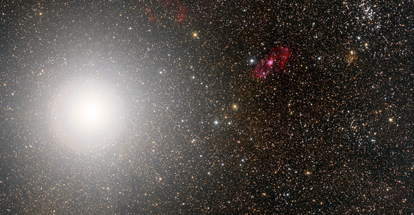
Close neighbor Alpha Centauri, 4.3 light-years distant [Lorenzi]
Possible Shortcut to Finding Extrasolar Planets
September 2014
Forbes magazine recently featured research by Ivan Ramirez, who is known for work with stars closely resembling our sun. Dr. Ramirez and colleagues hypothesize that a slight depletion of the key metals that comprise rocky planets--barium, aluminum, iron, magnesium, titanium, chromium, silicon, yttrium--in the spectra of stars similar to the sun, may indicate the presence of planets, just as in our solar system.
Nearby Star 'Alpha Centauri A' May Harbor Rocky Planets: 'Find' Heralds Planet-Hunting Shortcut.
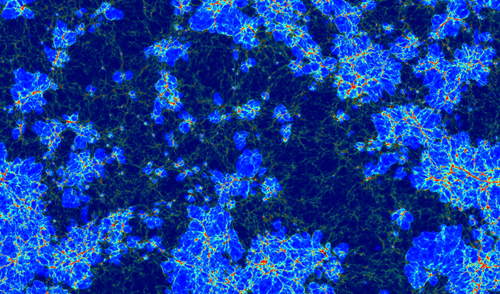
[Park, Shapiro, Choi, D'Aloisio]
First Billion Years: The Epoch of Reionization
Prof. Paul Shapiro's Cosmology Research Group has performed one of the world's largest and most sophisticated computer simulations of the transformation of the early universe--from a featureless expanding gas, to a place where galaxies formed, stars formed within those galaxies, and radiation from the stars ionized the neutral hydrogen in the vast intergalactic regions.
The visualization is among a collection of images solicited by the College of Natural Sciences to illustrate the beauty of science.
View an excerpt of the simulation, and an explanation by Prof. Shapiro at:
Visualizing Science 2014: Beautiful Images From College Research
McDonald Observatory: Brain Motor
StarDate Radio host Sandy Wood narrates a 15-minute overview of McDonald Observatory, from a 1926 financial gift from Paris, Texas banker William J. McDonald, to the current leading-edge search for Dark Energy at the Hobby-Eberly Telescope. Historic footage and interviews with observatory directors and research scientists chronicle dramatic changes in research methods, advancing engineering capabilities, the construction of new telescopes, evolving science, and the development of one of the world's largest public outreach centers.

Texas Astronomy Undergraduate Research Symposium 2014
September 2014
The University of Texas at Austin Department of Astronomy will be hosting the fourth annual Texas Astronomy Undergraduate Research Symposium on Friday, September 19, 2014. Undergraduates from central Texas are invited to give 10 minute talks on their astronomy research, based on either their summer or academic year research projects. Other students, postdocs, and faculty are invited to attend and hear about the first-rate research being done by these undergraduates.

The Inner Regions of Quasars
September 2014
The symposium The Inner Regions of Quasars will be held Friday, September 12th through Sunday, September 14th, 2014 on the 15th floor of Robert Lee Moore Hall (RLM) [map] on the campus of The University of Texas at Austin, to celebrate the work and career of Dr. Beverley Wills. Bev has been one of the pioneers in observing and interpreting the broad emission lines in all types of AGNs. Her enthusiasm and dedication inspired a generation of researchers in the field. This meeting celebrates Bev's contributions (many with Derek Wills) by presenting new results and by reviewing what has been achieved recently in this area of research.
97-point grid of the spherical plane of focus. [John Good]
HETDEX Update: Tracking Sphere
August 2014
Mechanical Engineer John Good was in West Texas in late July to run point tests with HET's new tracker. The tracker sits 13 meters above the stationary primary mirror array, and moves within six axes (hexapod), to track stars. The image above defines the contact lens shaped plane along which the tracker must move to both track a star and maintain focus. These plotted, six axis measurements are accurate enough to quantify the deflection of the HET frame as the tracker assembly moves. The 20-ton, automated tracker will routinely traverse the focal sphere with a precision of a few microns, about 1/10th the diameter of a human hair.
Keep up with the HET Wide Field Upgrade at HET Blog.
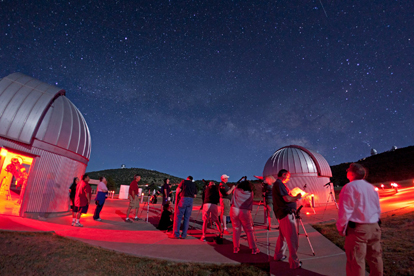
Summer Teacher Workshop at McDonald Observatory [Cianciolo]
Recently in the News
Presidio Passes Ordinance Dedicated to Preserving Night Skies
NewsWest 9
Looking into the past, future: 75 years of 'beautiful science'
Alpine Avalanche
Seeing Stars in Dripping Springs
The Texas Observer

Final Weekend
75th Anniversary Event
Bob Bullock Texas State History Museum
The McDonald Observatory: 75 Years of Stargazing
3rd Floor Rotunda Gallery through June 29. Admission is free.
Family Day: Starry Extravaganza - Saturday, June 28 - 12-3 pm
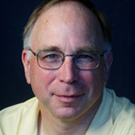
75th Anniversary Public Lecture
Exploring New Worlds:
Amazing Planets Orbiting Other Stars
--Dr. Bill Cochran
Bob Bullock Texas State History Museum
Saturday, May 24, 2:00 PM
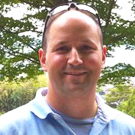
75th Anniversary Public Lecture
Billions of Years in the Making:
Very Distant Galaxies and the HETDEX Project at McDonald Observatory
--Dr. Steven Finkelstein
Bob Bullock Texas State History Museum
Saturday, May 10, 2:00 PM
Astronomy Undergraduates Earn Recognition
May 2014
With programs like the Freshman Research Initiative, UT Astronomy continues to develop as a leading program for high achieving undergraduates, who participate directly in research and publication with scientists and faculty. From left top: Arina Rostopchina, Outstanding Senior; James Diekmann, Ralph Cutler Greene Scholar; Rebecca Larson, Karl G. Henize Scholar; Mark Moore, Phi Beta Kappa; Amanda Turbyfill, Phi Beta Kappa; Sae Saito (not pictured), Eva Stevenson Woods Endowed Presidential Scholarship.

Coyne Gibson
Revolutionary IGRINS enters engineering runs
April 2014
McDonald Observatory's newest instrument, the Immersion Grating Infrared Spectrograph (IGRINS), began engineering runs in March. It will increase the spectral range, the range of instantaneous collectable wavelengths, 30x over the premier CRyogenic high-resolution InfraRed Echelle Spectrograph (CRIRES) at the European Southern Observatory's Very Large Telescope (VLT). IGRINS will have the ability to better penetrate dust obscured regions where stars and planets form, and will be used to find and characterize extrasolar planets. IGRINS will be available to observers as a PI instrument in Fall 2014.
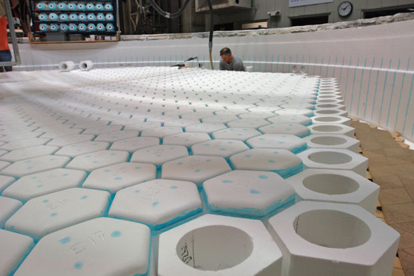
Honeycomb structure of Giant Magellan Telescope mirror 3 [Arizona Daily Star]
Giant Magellan Telescope 24.5-meter concept arose from image quality of the 6.5-meter Magellan Telescopes
Visible from the construction site of the Giant Magellan Telescope (GMT), at Chile's Las Campanas Observatory, sit the twin 6.5-meter Magellan telescopes, perhaps the best natural imaging telescopes in the world. GMT partner, the Carnegie Instution of Washington, on behalf of the Magellan Project, pioneered the structured monolith design behind the concept of the GMT. Read more about the Magellan Telescopes.
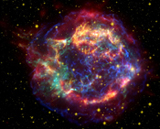
75th Anniversary Public Lecture
Cosmic Catastrophes: Supernovae Through Space and Time
Apr. 10 - Reception 6:30 PM, Talk 7:30 PM
Trinity Valley School, Fort Worth, TX
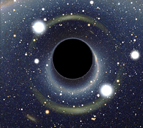
75th Anniversary Public Lecture
Black Holes, Dark Matter, and Dark Energy through the Eyes of Texas
Lamar Bruni Vergara Science Center
Laredo, TX
Wed., Apr. 2, 6:30 reception, 7:30 talk
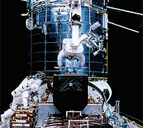
75th Anniversary Public Lecture
Hunting for Alien Worlds
Witte Museum
San Antonio, TX
Fri., Mar. 21, 6:30-8:30 PM
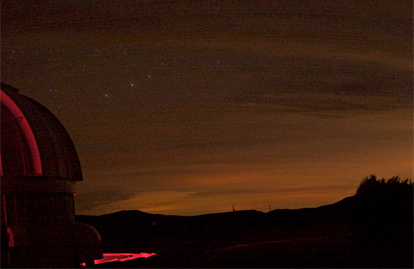
Bill Wren
West Texas Energy Boom A Threat to Astronomy
March 2014
A glow over the northern horizon at McDonald Observatory near Ft. Davis, Texas. The light is generated by round-the-clock oil and gas operations in the Permian Basin. Read more at Fronteras
UT Game Changers: Karl Gebhardt, Black Holes and Dark Energy
March 2014
In this excerpt from LHN Game Changers, University of Texas astrophysics professor Karl Gebhardt addresses some big issues in his work..
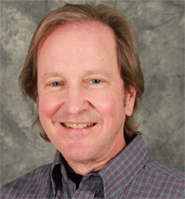
Dr. Don Winget
22nd Annual Great Lecture in Astronomy: Small Stars in a Large Context
February 2014
Prof. Don Winget, Harlan J. Smith Centennial Professor in Astronomy, will deliver the public lecture, "Small Stars in a Large Context," Saturday, February 22, 2014 at 1:00 PM, in POB 2.302 on The University of Texas at Austin campus. Dr. Winget will discuss white dwarf stars. White dwarfs are the simplest stars, with the simplest known chemical surface compositions, yet they exhibit properties to probe the widest parameters of the universe. Now, they have become the first stars ever produced in a lab! Discover McDonald Observatory's world leading, mind-expanding exploration of this amazing class of stars..
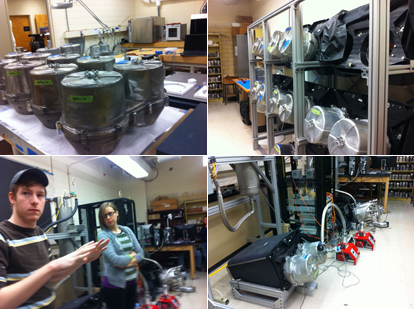
Assembly and alignment of VIRUS spectrographs
February 2014
The Hobby-Eberly Telescope in West Texas, is clearing room for the pending arrival of the first of 150 VIRUS spectrographs, undergoing assembly and alignment in Austin. Top left: units house optics and electronics in a vacuum. Top right: completed and aligned VIRUS pairs begin to fill a rack. Bottom right: optical fiber feeds the pairs during alignment, as mirrors and electronics are calibrated. Alignment alone requires about two days per pair. Bottom left: Trent Peterson and undergraduate Ingrid Johnson describe the demanding assembly. Learn more at HET Blog and HETDEX: Illuminating the Darkness.
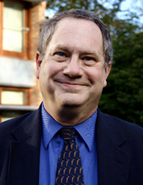
Dr. Robert C. Kennicutt, Jr.
Public Lecture: The Hidden Universe Revealed
February 2014
Dr. Robert C. Kennicutt, Jr., Plumian Professor of Astronomy and Experimental Philosophy at the Institute of Astronomy, University of Cambridge, will deliver the public lecture, "The Hidden Universe Revealed," Wednesday, February 19, 2014 at 4:00 PM, in CPE 2.208 on The University of Texas at Austin campus. Dr. Kennicutt will discuss completely new classes of objects and phenomenon revealed by international space telescopes observing in the infrared and terahertz, regions of the electromagnetic spectrum previously hidden from telescopes. Dr. Kennicutt is the 17th recipient of the Antoinette de Vaucouleurs Memorial Lectureship, recognizing a lifetime of outstanding contribution to Astronomy.
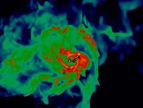
Heavy Metal in the early cosmos
National Science Foundation
January 2014
Simulations shed light on the formation and explosion of stars in the earliest galaxies.
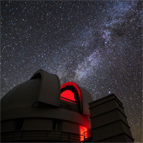
Texas Monthly
January 2014
The McDonald Observatory, celebrating its seventy-fifth anniversary this year, forges ahead with groundbreaking research and crusades to keep the night skies of West Texas pristine and unadulterated.
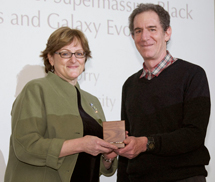
Presentation of the 2014-15 Antoinette de Vaucouleurs
Lectureship and Medal
Dr. Meg Urry, Israel Munson Professor of Physics and Astronomy, Chair of the Physics Department, and Director of the Yale Center for Astronomy and Physics Yale University, receives the Antoinette de Vaucouleurs Lectureship and Medal from Department of Astronomy Chair Dan Jaffe, recognizing outstanding contribution to Astronomy.
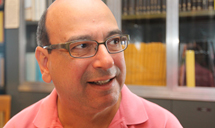
Dark Energy And The Expansion Of The Universe
New Director of McDonald Observatory Dr. Taft Armondroff talks with West Texas Public Radio on McDonald, Astronomy, and Philosophy (27:45)
Finding the Sun's Long Lost Sibling
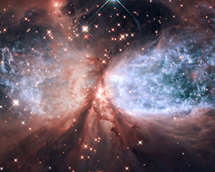
Public Lecture: Truth and Beauty in Astronomy Visualization
10 February 2014
Astrophysicist Dr. Frank Summers, from the Space Telescope Science Institute, will present the public lecture "Truth and Beauty in Astronomy Visualization", Thursday, March 6, 2014 from 7-8:00 PM, in ECJ 1.202. The talk will showcase compelling visuals and describe techniques used in creating sequences for schools, the press, planetariums, and IMAX films.
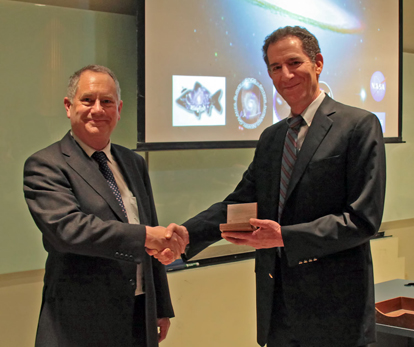
Presentation of the 2013-14 Antoinette de Vaucouleurs
Lectureship and Medal
Dr. Robert Kennicutt, Jr., Plumian Professor of Astronomy and Experimental Philosophy at the Institute of Astronomy, University of Cambridge, receives the Antoinette de Vaucouleurs Lectureship and Medal from Department of Astronomy Chair Dan Jaffe, recognizing a lifetime of outstanding contribution to Astronomy.


